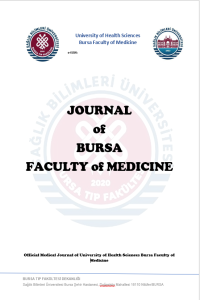Ovarian hyperstimulation syndrome developed in a patient who underwent neovagen with the diagnosis of Müllerian agenesis and was a candidate for uterine transplantation: Case Report
Ovarian hyperstimulation syndrome developed in a patient who underwent neovagen with the diagnosis of Müllerian agenesis and was a candidate for uterine transplantation: Case Report
We aimed to present OHSS that developed after OPU in a patient who underwent neovagen 10 years ago with the diagnosis of Müllerian agenesis and was awaiting uterine transplant. We wanted to draw attention to successful approaches in such groups of patients with Müllerian agenesis.
A 35-year-old sexually active patient who applied to the Gynecology and Obstetrics Emergency Service of our institution with the complaint of abdominal pain had zero gravida. In her anamnesis, a 15-year-old patient who applied to the obstetrics clinic with the complaint of primary amenorrhea was diagnosed with MRKH syndrome in an external center. Neovagen was performed by laparoscopic method due to vaginal agenesis of the patient in an external center in 2012. The patient was informed and admitted to the gynecology service for follow-up with the diagnosis of mild OHSS.
The patient was informed and admitted to the gynecology service for follow-up with the diagnosis of mild OHSS. During the follow-up period, waist circumference and weight did not increase, the follow-up was balanced, no free fluid was observed in the abdomen in the ultrasonography, there was no electrolyte imbalance, there was no deterioration in liver-kidney functions and hemoconcentration did not develop. The patient was discharged on the 3rd day of hospitalization due to the regression of abdominal pain.
OHSS may be one of the difficulties experienced by all Müllerian agenesis patients who decide to become a real family. These patients should be given up-to-date information about neovagen production, IVF processes and uterine transplantation by all obstetricians. Considering all of these approaches will raise awareness in this patient population, which faces a variety of lifelong challenges in starting a family.
Keywords:
ohss, neovagen, müllerian agenesis, uterine transplatation,
___
- Morcel K, Camborieux L, Guerrier D. Mayer-Rokitansky-KüsterHauser (MRKH) syndrome. Orphanet Journal of Rare Diseases. 2007; 2: 13.
- Practice Committee of American Society for Reproductive Medicine. Current evaluation of amenorrhea. Fertility and Sterility. 2008; 90: S219–S225.
- Herlin MK, Petersen MB, Brännström M. Mayer-RokitanskyKüster-Hauser syndrome: a comprehensive update. Orphanet Journal of Rare Diseases. 2020; 15: 214.
- Erman Akar M, Ozkan O, Aydinuraz B, Dirican K, Cincik M, Mendilcioglu I, et al. Clinical pregnancy after uterus transplantation. Fertil Steril 2013;100:1358-63.
- Tsirigotis M, Craft I. Ovarian hyperstimulation ayndrome (OHSS): how much do we really know about it? Eur J Obst Gyn and Repro Biol 1994;55:151-5.
- Papanikolaou EG, Pozzobon C, Kolibianakis EM, Camus M, Tournaye H, Fatemi HM, et al. Incidence and prediction of ovarian hyperstimulation syndrome in women undergoing gonadotropin-releasing hormone antagonist in vitro fertilization cycles. Fertil Steril 2006, 85:112-120.
- Schenker JG. Prevention and treatment of ovarian hyperstimulation. Hum Reprod 1993; 8:653.
- Aboulghar MA, Mansour RT. Ovarian hyperstimulation syndrome: classifications and critical analysis of preventive measures. Hum Reprod Update 2003; 9:275.
- Soares SR, Gómez R, Simón C, et al. Targeting the vascular endothelial growth factor system to prevent ovarian hyperstimulation syndrome. Hum Reprod Update 2008; 14:321.
- Delvigne A, Rozenberg S. Review of clinical course and treatment of ovarian hyperstimulation syndrome (OHSS). Hum Reprod Update 2003; 9:77.
- Bean, EJ., Mazur, T., Robinson, AD. (2009). ‘’Mayer-RokitanskyKüster-Hauser syndrome: Sexuality, psychological effects, and quality of life’’. Journal of Pediatric and Adolescent Gynecology 22: 339–346.
- Uncu G., Özerkan K., Ata B., Kasapoğlu I., Atalay M. A., Orhan A., et al. (2018). Anatomic and functional outcomes of paramesonephric remnant-supported laparoscopic double-layer peritoneal pull-down vaginoplasty technique in patients with Mayer-Rokitansky-Küster-Hauser syndrome: Uncu modification. Journal of minimally invasive gynecology, 25(3), 498-506.
- Heller-Boersma, J.G., Edmonds D.K.,Schmindt U.H. (2009). ‘’ A Cognitive Behavioural Model and Therapy for Utero-Vaginal Agenesis (MayerRokitansky-Kuster-Hauser Syndrome: MRKH)’’, Behavioural and Cognitive Psychotherapy,37, S:449-467.
- Heller-Boersma, J.G., Schmidt, U.H., Edmonds, D.K.(2009).’’ Psychological Distress in Women With Uterovaginal Agenesis (MayerRokitansky-Küsher-Hauser Syndrome,MRKH)’’. , Psychosomatics, 50(3).
- Lee M., Farrell, R. M., & Flyckt R. (2021). An insider perspective from Mayer-Rokitansky-Küster-Hauser syndrome patients on uterus transplantation. Fertility and Sterility, 115(4), 911-912.
- Saso S., Clarke A., Bracewell-Milnes T., Saso A., Al-Memar M., Thum, et al.(2016). Psychological issues associated with absolute uterine factor infertility and attitudes of patients toward uterine transplantation. Progress in Transplantation, 26(1), 28-39.
- Başlangıç: 2023
- Yayıncı: Sağlık Bilimleri Üniversitesi
Sayıdaki Diğer Makaleler
Analysis of Isolation Precautions in a Tertiary Training and Research Hospital
Ali ASAN, Canan DEMİR, Mustafa Özgür AKÇA, Ali GÜMÜŞ, Aysegul Ozdemir KAHRİMAN, Esra CAKİR GOKCEN
Temperature and holiday impacts on early childhood fracture.
Fatih TÜRKMENSOY, Nazan ÇEVİK, Yavuz AKALIN, Ali Ömer KAYA, Can ULUSALOĞLU, Alpaslan ÖZTÜRK
Elif YUCE BİLGİN, Yonca SATİCİ GUMUS, Evrim KOCA, Nefise Nazlı YENİGÜL
Congenital Syphilis as A Cause of Hydrops Fetalis: A Case Report
Zeynep ŞENOCAK, Bayram Ali DORUM, Şefika ELMAS BOZDEMİR
Innovations in the treatment of anemia in chronic kidney failure
